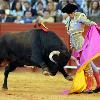Topics: Sports Tags: Bullfighting, Catalonia View |
Bullfighting (also known as tauromachy, from Greek (Greek language) ?????????? - tauromachia, "bull-fight"; or as corrida de toros in Spanish (Spanish language)) is a traditional spectacle of Spain, Portugal, some cities in southern France and in several Latin American countries, in which one or more bulls (cattle) are ritually killed in a bullring as a public spectacle. It can be considered a blood sport. In Portugal it is illegal to kill a bull in the arena. A nonlethal variant stemming from Portuguese influence is also practiced on the Tanzanian island of Pemba (Pemba Island).
The tradition, as it is practiced today, involves professional toreros (torero (bullfighter)) (toureiros in Portuguese; also referred to as toreadors in English), who execute various formal moves in order to subdue the bull (Spanish Fighting Bull). Such maneuvers are performed at close range, and have in some cases resulted in injury or death of the bullfighter. The bullfight usually concludes with the killing of the bull by a sword thrust. In Portugal the finale consists of a tradition called the pega, where men (forcados) try to grab and hold the bull by its horns when it runs at them. Forcados are dressed in a traditional costume of damask or velvet, with long knit hats as worn by the campinos (bull headers) from Ribatejo. Bullfighting has generated controversy in many parts of the world, including Spain, Portugal, Peru, Mexico, and Ecuador. Supporters of bullfighting argue that it is a culturally important tradition, while animal rights advocates hold that it is a blood sport resulting in the suffering of bulls and horses.
There are many historic fighting venues (Bullring) in the Iberian Peninsula and Latin America. The largest venue of its kind is the Plaza de toros M�xico in central Mexico City, which seats 48,000 people, and the oldest is the Plaza de Toros de Acho in Lima, Peru, which was built in 1766.



